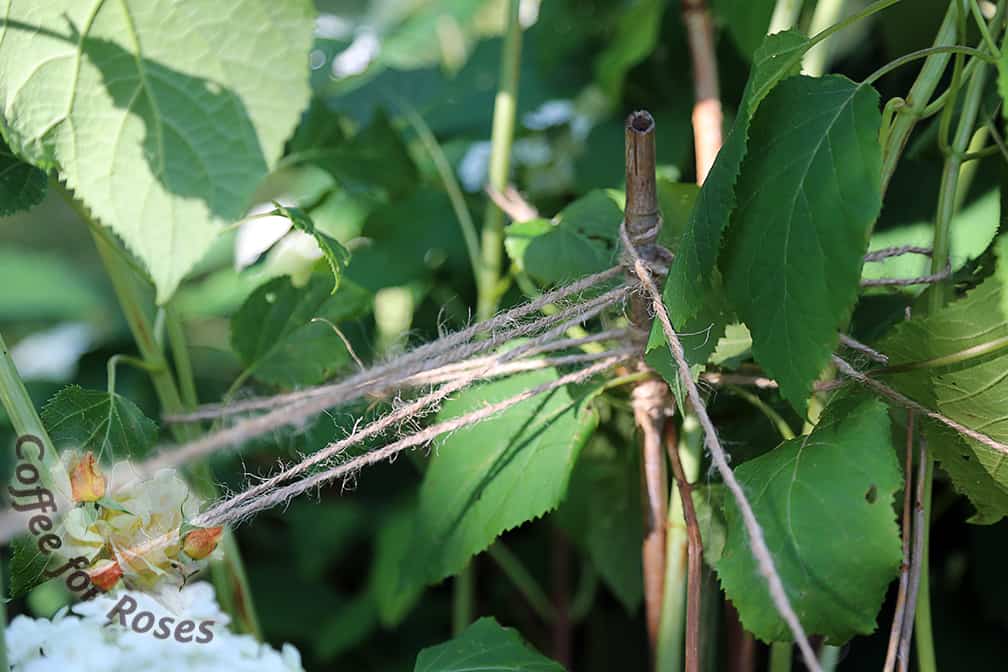To stake a hydrangea tree, find a sturdy stake and drive it into the ground near the base, then tie the tree to the stake using soft ties. When done correctly, staking a hydrangea tree provides support and stability, preventing it from being damaged by strong winds or heavy rain.
Staking a hydrangea tree is an essential step in ensuring its proper growth and development. In addition to providing support, staking also helps the tree maintain an upright position, prevents it from leaning, and protects it from potential damage caused by strong winds and heavy rain.
By following a few simple steps, you can stake your hydrangea tree successfully, promoting healthy growth and ultimately creating a stunning landscape feature. Here’s a concise guide on how to stake a hydrangea tree, ensuring its stability and longevity in your garden.

Credit: coffeeforroses.com
Benefits Of Staking A Hydrangea Tree
Staking a hydrangea tree brings several benefits to your garden. One of the main advantages is that it prevents leaning and bending of the tree’s branches. When a hydrangea tree grows taller, its branches may become heavy with flowers and foliage, causing them to lean or bend under their weight. By using stakes, you can provide support to the branches, ensuring that they grow upright and maintain their natural form.
Moreover, staking promotes healthy growth in hydrangea trees. By preventing leaning and bending, the stakes reduce the risk of branch breakage or damage. This allows the tree to allocate its energy towards producing new shoots, leaves, and vibrant flowers. Additionally, proper staking promotes better air circulation and sunlight exposure, which are essential for the overall health and development of the hydrangea tree.
Furthermore, staking a hydrangea tree enhances its aesthetic appeal. A well-staked tree exudes a sense of elegance and symmetry, creating a visually pleasing focal point in your garden. With the support of stakes, the tree can grow upright, showcasing its beautiful blooms at eye level. Staking also enables you to shape the tree’s growth, creating a desired form or espaliering it against a wall, enhancing its ornamental value and making it an attractive addition to your landscape.
When To Stake A Hydrangea Tree
Identify the ideal time to stake: Staking a hydrangea tree is essential for its proper growth and stability. The best time to stake a hydrangea tree is right after planting or during early spring, before new growth starts. This allows the tree to establish a strong root system and prevents it from leaning or bending in strong winds or rain.
Factors to consider before staking: Before staking your hydrangea tree, there are a few factors you should consider. Firstly, assess the tree’s overall health and strength. Healthy, vigorous trees may not require staking, as they have the ability to support themselves. However, if you notice any signs of weakness or leaning, staking might be necessary. Additionally, consider the tree’s location and the prevailing weather conditions. If your area experiences strong winds or heavy rainfall, staking can provide extra support and prevent potential damage.
How to Stake a Hydrangea Tree: Step by Step Guide
Choosing The Right Staking Materials
When staking a hydrangea tree, it’s important to choose the right materials to ensure proper support and growth. Understanding the different staking options available will help you make an informed decision.
One of the most common staking methods is using bamboo stakes. These are affordable and readily available, but they may not provide enough support for larger trees. Another option is the use of metal stakes, which are sturdy and durable. However, they can be more expensive and may require special tools for installation.
Another staking option is using a stake and tie system. This involves using a stake and attaching the tree to it with ties. This method allows for flexibility and prevents the tree from leaning or being restricted. However, it requires regular maintenance to ensure the ties do not damage the tree.
When selecting the appropriate materials for your tree, consider the size and weight of the hydrangea tree as well as the surrounding environment. For small trees, bamboo stakes or stake and tie systems are suitable options. For larger trees or areas with high wind, metal stakes may be a better choice. Always make sure to check the staking materials regularly to ensure they are providing adequate support.
Properly Stake A Hydrangea Tree
Staking a hydrangea tree properly is essential for its growth and stability in your garden. To begin, prepare the tree by checking for any damaged or weak branches. Pruning them will ensure the tree can withstand the staking process.
The next step involves positioning the stakes. Place them at equal distances around the tree, ensuring they are driven deep into the ground to provide sufficient support. At least two stakes would be ideal for smaller trees, while larger ones may require more.
Once the stakes are in place, attach the tree to them using soft ties or velcro straps. These materials will secure the tree without causing damage. Be careful not to tie the plant too tightly to allow for some movement and natural growth.
Regularly check the stakes and the tree during its growth. Ensure the supports are adequately providing support as the tree grows taller and wider. Adjust the stakes as needed to prevent any restrictions on the tree’s development.
Following these steps will contribute to the success of staking a hydrangea tree, promoting healthy growth and beautiful blooms!
Caring For A Staked Hydrangea Tree
A staked hydrangea tree requires regular monitoring and maintenance to ensure its healthy growth. Pruning techniques play a crucial role in shaping the tree and promoting optimal growth. It is important to remove any dead or damaged branches, trimming them close to the trunk or parent branch. This encourages new growth and prevents the spread of diseases. Additionally, watering and fertilizing tips are vital for the well-being of the tree.
Watering deeply and infrequently, especially during hot and dry periods, helps develop a robust root system. Applying a slow-release fertilizer, specifically formulated for hydrangeas, in early spring and again in mid-summer can provide the necessary nutrients. Lastly, establishing a staking maintenance routine is key. Regularly check the tree’s ties to prevent girdling or excessive pressure on the trunk. Adjust the ties as the tree grows to maintain proper support and prevent damage. By following these practices, you can ensure the success and beauty of your staked hydrangea tree.
Frequently Asked Questions Of How To Stake A Hydrangea Tree
How Do You Stake A Hydrangea Tree?
To stake a hydrangea tree, begin by placing a stake in the ground next to the tree. Use a tree tie or flexible material to attach the tree to the stake, making sure it is secure but not too tight.
Regularly check the tie to ensure it isn’t causing damage to the tree as it grows.
When Should You Stake A Hydrangea Tree?
It is best to stake a hydrangea tree when you first plant it, or if it is weak or top-heavy. Staking can help provide support and prevent the tree from leaning or falling over. Check the tree periodically and remove the stakes once the tree has established a strong root system.
What Materials Are Needed To Stake A Hydrangea Tree?
To stake a hydrangea tree, you will need wooden or metal stakes, tree ties or flexible material, and a hammer or mallet to secure the stakes in the ground. You may also need a shovel or post hole digger to create a hole for the stakes.
How Long Should You Leave A Hydrangea Tree Staked?
You should leave a hydrangea tree staked for about one year or until it has established a strong root system and can support itself. It is important to regularly check the tree and remove the stakes if they are no longer needed to prevent damage or restriction as the tree grows.
Conclusion
Staking a hydrangea tree is a crucial step in ensuring its proper growth and stability. By following the steps outlined in this blog post, you can provide the necessary support and protection to your hydrangea, preventing it from being damaged by strong winds or heavy rainfall.
Remember to choose the appropriate staking method, securing the plant firmly without causing any harm. With proper staking, you can enjoy a healthy and flourishing hydrangea tree in your garden for years to come.

